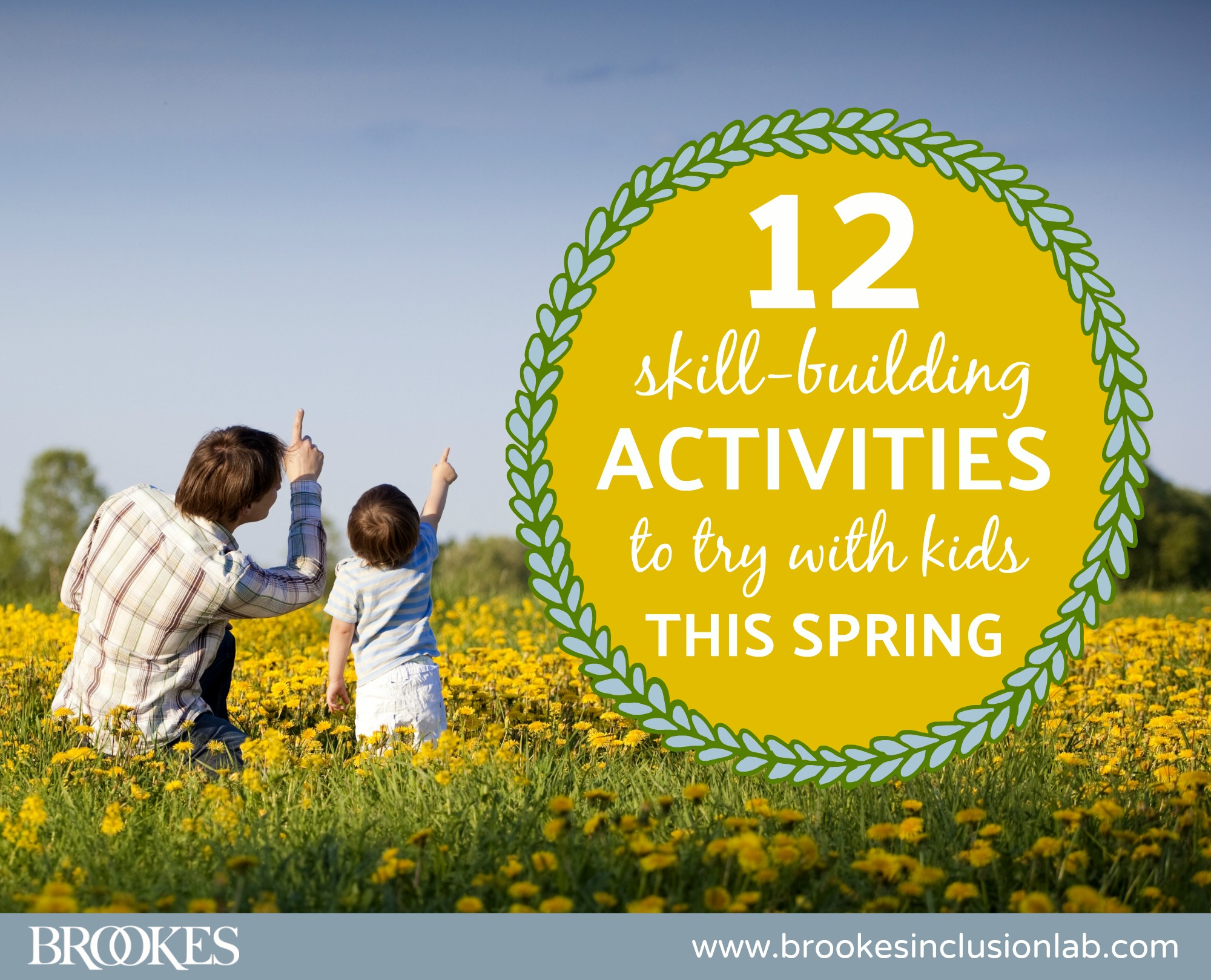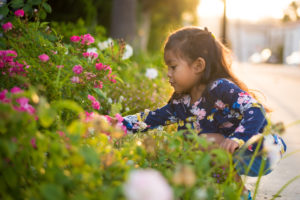12 At-Home Spring Activities to Boost Your Child’s Development
April 7, 2020
As families stay at home to preserve health and safety this spring, many parents of young children—especially parents who are working remotely—are struggling just to get through the day. With work hours often spilling into evening hours, not every parent has the time to create a color-coded roster of activities for their restless and energetic young children. And those fun excursions that typically provide a little respite, from family trips to local day jaunts, won’t be possible this spring as stay-at-home orders continue to affect much of the country.
Fortunately, it’s often the simple, at-home activities that give kids the most joy (and teach them critical new skills at the same time).  In today’s blog post, we’re sharing 12 low-tech spring activities that homebound parents can try with their young children whenever they have a bit of free time. These suggestions were inspired by and adapted from the ASQ-3 Learning Activities (for key developmental areas) and the ASQ:SE-2 Learning Activities (for key social-emotional areas). Share this article with parents of young children—especially #12, which includes a link to fill out an ASQ questionnaire for free!—and give them some easy ideas for skill-boosting learning experiences with their children.
In today’s blog post, we’re sharing 12 low-tech spring activities that homebound parents can try with their young children whenever they have a bit of free time. These suggestions were inspired by and adapted from the ASQ-3 Learning Activities (for key developmental areas) and the ASQ:SE-2 Learning Activities (for key social-emotional areas). Share this article with parents of young children—especially #12, which includes a link to fill out an ASQ questionnaire for free!—and give them some easy ideas for skill-boosting learning experiences with their children.
Have a teddy bear picnic. Spring is the perfect season for picnics—and you can still have them right in your backyard, on your balcony, or even in your living room. To make yours extra special (and give social and communication skills a boost), have your child bring their teddy bears or other favorite stuffed animals on the picnic. Pack a basket just for the bears with a blanket, napkins, pretend food, and plastic plates and tea cups. You and your child can have fun “talking for” their furry friends and imagining their picnic conversations. When your picnic is done, have your child (and the bears!) help you clean up.
 Create (and send!) flower cards. This notecard activity helps kids practice fine motor and social skills, and it’s a creative way to stay in touch with faraway family and friends. Collect small and delicate wildflowers from your backyard or another outdoor area where you can maintain social distance safely. Show children how to place the flowers between sheets of paper towels or newspaper and then lay them between heavy books. Give the flowers a few days to dry and flatten out, and then work with your child to glue your pretty dried-flower creations to pieces of folded cardstock. Help your child write a special message inside one or more of the cards and send them off to grandparents or other loved ones. (If you can’t mail them, you can take photos and send the cards via text or email.)
Create (and send!) flower cards. This notecard activity helps kids practice fine motor and social skills, and it’s a creative way to stay in touch with faraway family and friends. Collect small and delicate wildflowers from your backyard or another outdoor area where you can maintain social distance safely. Show children how to place the flowers between sheets of paper towels or newspaper and then lay them between heavy books. Give the flowers a few days to dry and flatten out, and then work with your child to glue your pretty dried-flower creations to pieces of folded cardstock. Help your child write a special message inside one or more of the cards and send them off to grandparents or other loved ones. (If you can’t mail them, you can take photos and send the cards via text or email.)
Build a rainy-day hideaway. What was more fun than a hideaway or fort when you were little? When April showers put the brakes on backyard play, ask if your children would like to build a special hideaway. Siblings can work together, or you can collaborate with your child. Have the kids build a tent by draping old sheets or blankets over furniture. Once they make their tent, they can play in it, eat lunch inside it, or read books together with a flashlight. (For extra motor skills practice, ask the children to help you put the tent away at the end of the day. They can help you fold the sheets by finding a corner and bringing it to you.)
 Have a cloud chat. On a beautiful spring day when the sky is filled with puffy clouds, try this classic activity, a calming and creative way to build communication skills. Go outside with your child and lie on your back together in the grass (bring a blanket if you like) or sit together on a porch, on a balcony, or near a window where you can see the sky. Take turns describing the different cloud shapes and patterns. Point out the “cloud pictures” you see, and ask your child to describe what they think the clouds look like: “Look. There’s an ice cream cone! What do you see in the clouds?”
Have a cloud chat. On a beautiful spring day when the sky is filled with puffy clouds, try this classic activity, a calming and creative way to build communication skills. Go outside with your child and lie on your back together in the grass (bring a blanket if you like) or sit together on a porch, on a balcony, or near a window where you can see the sky. Take turns describing the different cloud shapes and patterns. Point out the “cloud pictures” you see, and ask your child to describe what they think the clouds look like: “Look. There’s an ice cream cone! What do you see in the clouds?”
Make water pictures. This outdoor activity is a good choice for the first really dry, warm day of the season. Give your child a plastic bucket of water, a paintbrush, and an old sponge. On a safe paved driveway or wooden fence, let the child paint “disappearing pictures” with the water on the cement or wood. Watch the pictures disappear as the water evaporates. Ask your child why they think the pictures vanished, and talk about what happens when water evaporates into a gas.
String a flower garland. Make this spring-themed decoration with your child to sharpen fine motor skills. First, help your child cut small flowers out of colored paper and punch a hole in the center of each one. Then, cut some drinking straws into pieces (you can also use short pasta tubes and paint them). When you’ve got all the pieces ready, show your child how to string the flowers and straw/pasta pieces onto a long piece of string. You can show them how to make a simple pattern—flower, straw, flower, straw. When your child is done with the garland, hang it up on your door or inside the house to celebrate spring.
 Set up a treasure hunt. Here’s an idea for helping kids exercise their problem-solving skills: Hide “treasures” such as a favorite snack, a bag of crayons, or some stickers in places your child can reach. Draw a map that highlights each area where you want your child to search for treasures. Be sure to make the drawings on your map simple and clear, and celebrate when your child finds all the treasures. (Spring-themed activities like indoor or outdoor egg hunts can be extra fun with the added twist of a treasure map.)
Set up a treasure hunt. Here’s an idea for helping kids exercise their problem-solving skills: Hide “treasures” such as a favorite snack, a bag of crayons, or some stickers in places your child can reach. Draw a map that highlights each area where you want your child to search for treasures. Be sure to make the drawings on your map simple and clear, and celebrate when your child finds all the treasures. (Spring-themed activities like indoor or outdoor egg hunts can be extra fun with the added twist of a treasure map.)
Play a Guess-What Game. This is a fun game for the whole family and a good communication booster for kids. Cut spring-themed pictures from a magazine, draw them, or find some online and print them out. (You might include a bunny, a chick, a butterfly, a bee, a painted egg, jellybeans, an Easter basket, spring flowers like daffodils and tulips, and rain galoshes.) Turn the pictures face down and have one family member choose a picture. The others ask yes-or-no questions to guess what the photo is: “Is it an animal?” “Does the animal fly?” “Does it have feathers?” After someone guesses correctly, another person chooses a picture and lets the others guess.
 Have some photo fun. Get dressed up in your favorite spring outfits, take a new family photo, and print it out. (Or have your child draw your family.) Then help your child make a picture frame for your family photo. Cut out two rectangles of stiff paper, a little larger than the picture. On one, cut another rectangle inside that’s a little smaller than the picture. Have your child decorate this part of the “frame” with spring-themed stickers, glitter, flowers, macaroni, or anything else that strikes their fancy. Glue the photo to the large solid rectangle, place the decorated frame over the picture, and glue the edges securely to finish your memento.
Have some photo fun. Get dressed up in your favorite spring outfits, take a new family photo, and print it out. (Or have your child draw your family.) Then help your child make a picture frame for your family photo. Cut out two rectangles of stiff paper, a little larger than the picture. On one, cut another rectangle inside that’s a little smaller than the picture. Have your child decorate this part of the “frame” with spring-themed stickers, glitter, flowers, macaroni, or anything else that strikes their fancy. Glue the photo to the large solid rectangle, place the decorated frame over the picture, and glue the edges securely to finish your memento.
Finish bathtime with a “tub scrub.” After a long day, a good soak in the tub is relaxing and calming. Add some motor-skills practice to bathtime by asking your child to help you clean the tub after their bath. Give your child a separate sponge or cloth just for this job and show them how to scrub all the way around the tub. (Don’t use other cleansers or chemicals with young kids—just the water will do fine.) As the water drains out, your child can “scrub” the part of the tub where the water was. When they’re finished, show them how to squeeze the cloth or sponge really hard, and praise them for being a good helper.
 Read together every night. End your days at home together by snuggling up with your child for some shared reading. It’s one of the single most important activities you can do together—not only does it strengthen your child’s communication and language skills, it’s also the perfect way to bond, talk through any tough emotions your child might be having, and end the day on a positive note. Choose some spring-themed books, or select stories that feature characters struggling with challenges or difficult emotions. Kids might find this type of story especially reassuring at a time of uncertainty and upheaval. Engage your child while you read and ask them questions about the story and the characters’ feelings.
Read together every night. End your days at home together by snuggling up with your child for some shared reading. It’s one of the single most important activities you can do together—not only does it strengthen your child’s communication and language skills, it’s also the perfect way to bond, talk through any tough emotions your child might be having, and end the day on a positive note. Choose some spring-themed books, or select stories that feature characters struggling with challenges or difficult emotions. Kids might find this type of story especially reassuring at a time of uncertainty and upheaval. Engage your child while you read and ask them questions about the story and the characters’ feelings.
Do a quick check of their milestones. One of the most important things you can do this spring is check to see if your child’s overall developmental skills are on track in all the areas mentioned in this article. You can do that for free in about fifteen minutes or less. Fill out an online ASQ questionnaire to see what your child’s biggest strengths are, uncover new milestones to celebrate, and reveal any areas where your child may need extra support. (You can access the questionnaire here.)
With the tips in this article—and your own creative ideas—you can transform your spring days into a rich and varied learning experience from the safety of home. The kids will be having so much fun, they’ll never guess you’re teaching them new skills they’ll use forever. Whatever activities you choose to do with your child this season, enjoy exploring, discovering, and learning together.
Want a printable version of this article? Access the PDF version here.
P.S. Don’t forget that activities should be supervised at all times by an adult. Any material, food, or toy given to a young child should be reviewed for safety.
TRY AN ASQ QUESTIONNAIRE
GET THE ASQ-3 LEARNING ACTIVITIES
GET THE ASQ:SE-2 LEARNING ACTIVITIES




Write a Comment
Your email address will not be published. Required fields are marked *
comments
Eve Smith says
I love this. Is this in a printable or downloadable format so that I can send to families in there transition packets. I would also want to know if it is available in Spanish.
jlillis says
Hi Eve,
Unfortunately, we don't have a translation available at the moment, but I will pass that on and let the rest of our team know there's interest. Let me see what I can do about getting this in a printable format for you.
jlillis says
Update for you! A link to the new PDF version has been added to the end of the post.
Martha says
Maybe whole year activity? Chess gives children the opportunity to make many new friends by participating in chess schools or local amateur tournaments. Probably I don't need to mention that chess develops concentration, increases patience and positively affects the intellectual and emotional development of the child. When a child learns the basic moves and “knows” how to play, it is worth raising the level of difficulty. To do this, just take some more exercises, like solve some chess puzzles (net-bossorg/chess-puzzles-for-kids-by-maksim-aksanov).
Post a Comment